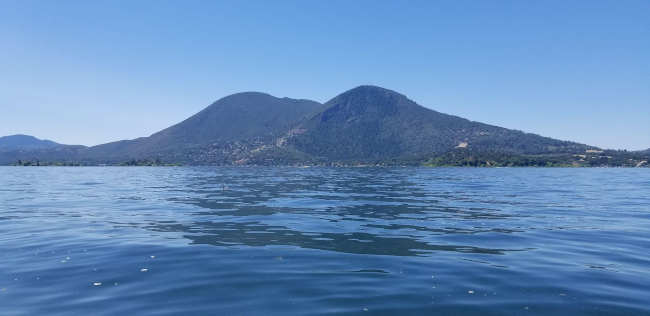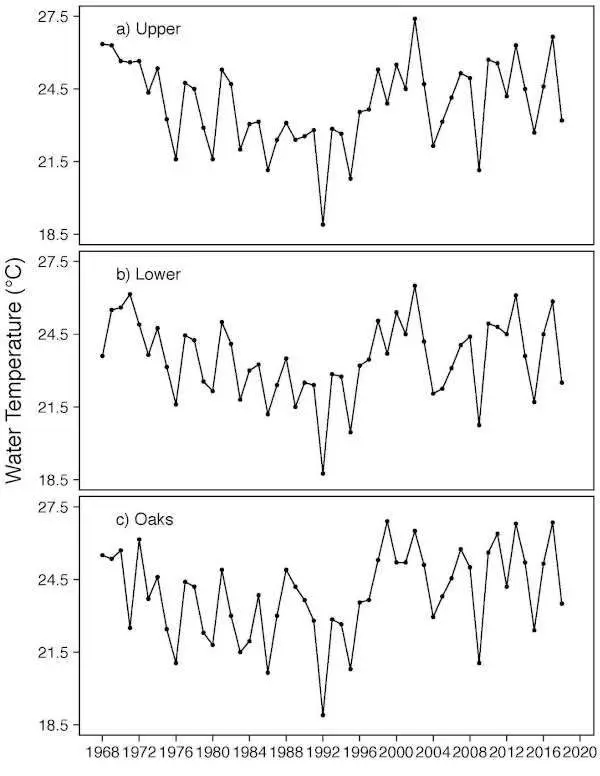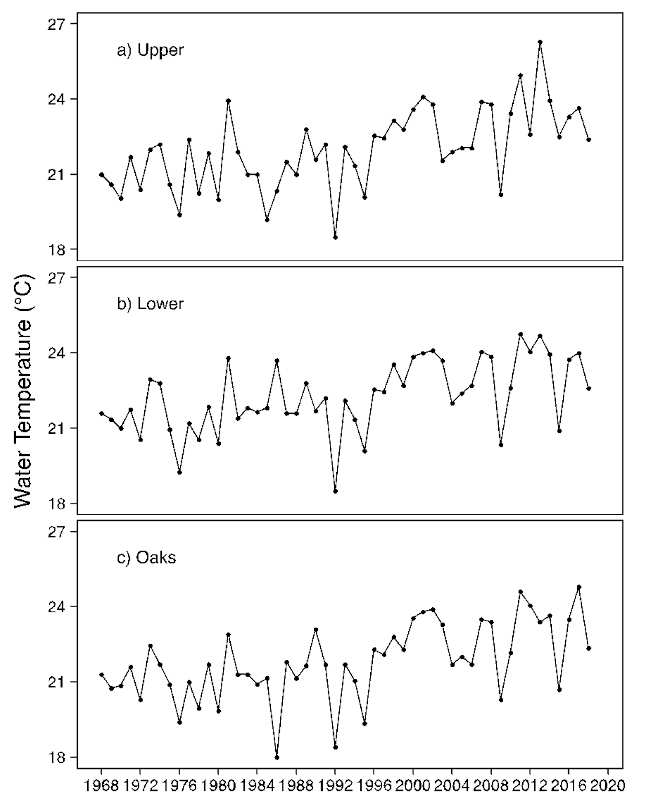
Dear Lady of the Lake,
It’s spring on Clear Lake. The days are getting warmer. How does temperature affect Clear Lake and are the patterns in temperature changing?
Thanks!
— Temperature Time Toma
Hello Toma,
What a great question! I am very happy to be able to chat about lake temperature today as it's very important when studying lakes and trying to understand how to manage a lake.
Today’s column will be about one of the basic principles in limnology, or the study of inland freshwaters, like lakes, ponds, wetlands, creeks and streams. Temperature is part of a group of physical factors when talking about lake science, as opposed to biological (i.e. fish or algae) or chemical factors (i.e. nutrients or metals).
In limnology, the majority of lakes that are studied and were used to form the base of limnological principles that are applied to lake science today are mostly those that include lakes that ice over. That is because the majority of lakes studied by the first limnologists were located near universities in northern latitudes such as Europe, Canada, and the Upper midwest and North Eastern regions of the US.
The study of shallow lakes, and lakes in temperate and tropical climates, is still developing, and many of the principles of these types of lakes are very different then those traditionally included in the history of limnology. Clear Lake is a prime example in that it’s relatively shallow (average about 27 feet in depth) and located in a temperate, or mediterranean, climate and does not experience ice over.
In fact, Clear Lake is very shallow when compared to the majority of other lakes and reservoirs in California and in North America. Lake depth influences water temperature and temperature is important for physical, biological and chemical processes throughout a lake. One of the most important physical processes that occurs in a lake is called lake mixing, or when layered temperatures throughout the water column are “mixed” and the entire water column becomes homogeneous in temperature.
Lake turnover and thermal stratification
A shallow lake, like Clear Lake, can mix many times a year, and sometimes the water column will completely mix for many days in the spring and summer due to wind events. The wind on the surface of the water will literally push the rest of the water in the water column around, causing complete mixing from the top of the surface to the bottom.
A lake that is well-mixed, or mixes multiple times a year, is called polymictic, and acts and behaves very differently than a lake that is polymictic, meaning it doesn't mix more than two times a year.
When you think of a story-book “traditional” deep lake, it’s probably in the dimictic category. For example, large lakes like Lake Superior, Lake Champlain, can be deep and cold and are dimictic. Sometimes dimictic lakes ice over, but not all of them, like Lake Tahoe. Lake mixing happens when there is a change in temperature to the surface layer of a lake, usually a warming, that causes a shift of the surface water into the bottom zone. Density also plays a factor as colder, denser water will want to sink, and displace, or turnover, warmer, less dense water.
If you want a quick tutorial in temperature, density, and lake stratification check out this 3 minute video produced by student members of the North American Lake Management Society, or NALMS.
The first mixing happens in fall as the colder air temperatures makes the surface layer (epilimnion) of the lake colder, and more dense, then the warmer bottom layer (hypolimnion). The top layer rotates with the bottom layer and the entire water column becomes mixed.
Then during winter, the lake stabilizes, or thermally stratified, with distinct layers separated by temperature and density. The top layer is cold, being exposed to freezing winter temperatures and the bottom layer, while still cold, is not freezing at 4o F, which is the temperature where water is the most dense.
When a lake is thermally stratified, there is a middle layer, called the metalimnion. And this layer is a middle temperature between the surface and bottom. Not all lakes have a metalimnion, Clear Lake for example, when it’s fully stratified, will not have a metalimnion, because it’s so shallow, there literally is not room, the transition zone in the lake from the top, epilimnion to the bottom, hypolimnion layer is at most smaller than a meter thick.
During the spring, when warmer, strong winds move the surface of the water, you can actually get the entire water column to be the same temperature, which leads to what's called “spring turnover”. This turnover event happens when the lake water column becomes mixed due to the equalized temperature between top and bottom layers, due to the strong warm winds increase the temperature of the cold surface layer and force it into the bottom layer, warming the entire water column.
Then in summer, the top layer is warmest, and the least dense, and sits on top of the cooler, more dense middle and bottom layer, making the lake stratified once again. Until fall when cooling air temperatures facilitate the whole cycle all over again.
Now this mixing cycle refers to a typical deep lake, and while it doesn’t always apply to Clear Lake, the Oaks and Lower arm sometimes are stratified.
Lake mixing in Clear Lake
Monthly monitoring by the Water Resources Department includes sampling a temperature profile. Where a probe, with a temperature gauge, is dropped down into the water column every meter to determine the temperature profile of the water column from the surface to the bottom.
A stratified lake is determined when at some point before the bottom there is a significant change, or decrease in temperature. This can sometimes be 5 or even 10 degrees in Clear Lake! In deeper lakes this can be 20 degrees or more. Technically, this is called a thermocline, which is the depth or depth range where the temperature changes between the epilimnion top layer and the bottom hypolimnetic layer.
Clear lake experiences polymixis, which means Clear Lake is mixed more than twice a year. In the summer, thanks to wind activity combined with shallow water, Clear Lake mixes very readily. According to current research by UC Davis, Clear Lake mixes on a daily and weekly basis throughout summer.
To see current and past wind conditions on Clear Lake, visit the UC Davis Tahoe Environmental Research Center, or TERC’s data page for Clear Lake Wind Maps. Scroll to the bottom of the page and you can visit real time wind animations, vector, and streamlines wind data, along with the station locations collecting the data.
Now lake mixing is a physical process, with biological impacts. Every time a lake turns over, or mixes, the process of water moving from top to bottom brings bottom nutrients, like nitrogen and phosphorus, to the surface of the lake. In an oligotrophic lake (or low productive lakes, opposite of Clear Lake) or the ocean, this is extremely beneficial because this process moves needed nutrients from the bottom to the top, where, combined with light and warm temperatures, the nutrients provide a valuable food source for algae — the base building block of the aquatic food web.
Likewise, turnover can move particles and materials at the surface of the water (think abundant algae and cyanobacteria cells in Clear Lake) to the bottom of the lake, where they will break down with bacterial microbes back into nutrients and wait to be mixed back into the water column during the next mixing event.
As one can imagine for Clear Lake, when you have warm, high winds in summer, accompanied by long daylight hours and warm air temperatures, you can see how there is a temperature-induced cycle of algae and cyanobacteria positive feedback loop throughout the water column.
Temperature trends in Clear Lake
Toma you also asked about the changes in temperature over time. Well thankfully, there is a long data record for Clear Lake. Since the 1960s, the California Department of Water Resources, with support from other state and local agencies, has been monitoring the lake temperature on a monthly basis. That data is freely accessible on the DWR Water Data Library page.
When I started working in Lake County (in 2018), I wanted to conduct some research that identified impacts of climate and wildfire on Clear Lake water quality. One of the major results of the research was an investigation on the warming trends of surface and bottom water temperatures in Clear Lake.
I partnered with a couple of limnologist researchers, Dr. Ian McCullough from Michigan State University, and Dr. Jennie Brentrup of the Cary Institute of Ecosystem Studies, to identify how temperatures have changed in Clear Lake and what could be the impacts.
We published the findings of this investigation in the publically accessible online peer-reviewed journal, Ecosphere, in the article “Turning up the heat: Long-term water quality responses to wildfires and climate change in a hypereutrophic lake.”
We wanted to specifically investigate if temperature was connected to a specific nutrient, phosphorus. Phosphorus has been shown to drive the formation of harmful algae blooms (or HABs) of cyanobacteria in Clear Lake.
You can learn more about cyanobacteria in Clear Lake by referring to my July 2021 Column, Concerned about Cyanobacteria in Soda Bay.
Cyanobacteria are majorly a problem in the summer and fall months, so to gain insights to the temperature during these time periods we focused our study on monthly temperature data collected between July and October from 1968 - 2019.
The DWR collected temperature profiles in Clear Lake, so we were able to look at the trends in not just surface epilimnetic temperature but also bottom hypolimnetic temperature. Now here is the fun math talk! We plotted monthly median temperatures and to see if there was rate of change, we used a special non-parametric statistical analysis called Thiel-Sen Slopes Estimator.
Thiel-Sen slopes represent medians of all pairwise differences between each annual timestep (change between the medians for each year), which can result in a calculated rate of change, either an increase or a decrease over time. To identify if this rate of change was meaningful, or statistically significant, we used Kendall’s p value (which treats the temperature and date data as a correlation to see if the rate of change is significant compared to no rate of change).
We used medians for this analysis as opposed to means or averages and Thiel-Sen is created for median datasets. We used medians because this descriptive statistic does a better job of capturing the typical temperature values and is more ecologically meaningful. The wild swings at the high / low ends in a natural set of data can influence mean calculations and makes for messy data that can’t be easily interpreted.
What we found wasn’t too surprising. Surface water temperatures have increased in Clear Lake, most significantly since 1985, and bottom temperatures have also increased significantly over the entire sampling period. Air temperatures globally are increasing, so it makes sense that water temperatures are also following suit.
Warmer waters, at the surface and bottom of Clear Lake, can lead to increased algae and cyanobacteria growth. Increased green algae, or phytoplankton, growth is good news for our fisheries, as phytoplankton is the base of the food web in Clear Lake, meaning more food is available for all the fish species throughout the lake. Likewise, warmer temperatures mean more cyanobacteria growth is also occurring, which means more HABs and nuisance conditions caused by the blooms.
Additional side effects of increasingly warmer waters is a decrease in oxygen in the water column. Oxygen is important for all biological processes as living things, such as insects and fish, that live in the lake and need oxygen to breathe. Warmer water holds less oxygen in colder water, meaning the warmer the water gets the less oxygen it can hold and the less life it can support.
So even if we have more phytoplankton, or food for fish, the system can’t support more fish because the oxygen will be limited due to the warmer temperatures. Sometimes fish mortality events, or fish kills, can occur when enough oxygen is depleted from the water.
Learn more about fish kills in my column Lady of the Lake: Figuring out Fish Kills (August 2021) and how temperature and oxygen play an important role in fish ecology. This is a very important concept as recent, unpublished research by the USGS has demonstrated that a majority of fish species in Clear Lake have been decreasing in numbers in recent years, and warmer waters and lower oxygen concentrations could be potential, but very important, factors for this alarming decline.

Sincerely,
Lady of the Lake
Angela De Palma-Dow is a limnologist (limnology = study of fresh inland waters) who lives and works in Lake County. Born in Northern California, she has a Master of Science from Michigan State University. She is a Certified Lake Manager from the North American Lake Management Society, or NALMS, and she is the current president/chair of the California chapter of the Society for Freshwater Science. She can be reached at This email address is being protected from spambots. You need JavaScript enabled to view it..
The Lady of the Lake will be available in-person to answer your lake questions on Saturday, May 13, at the Big Valley Small Farms Tour. The booths will be at Ripe Choice Farm from 10 a.m. to 3 p.m. The tour is open to the public. The Lady of the Lake wil see you there!



 How to resolve AdBlock issue?
How to resolve AdBlock issue? 





